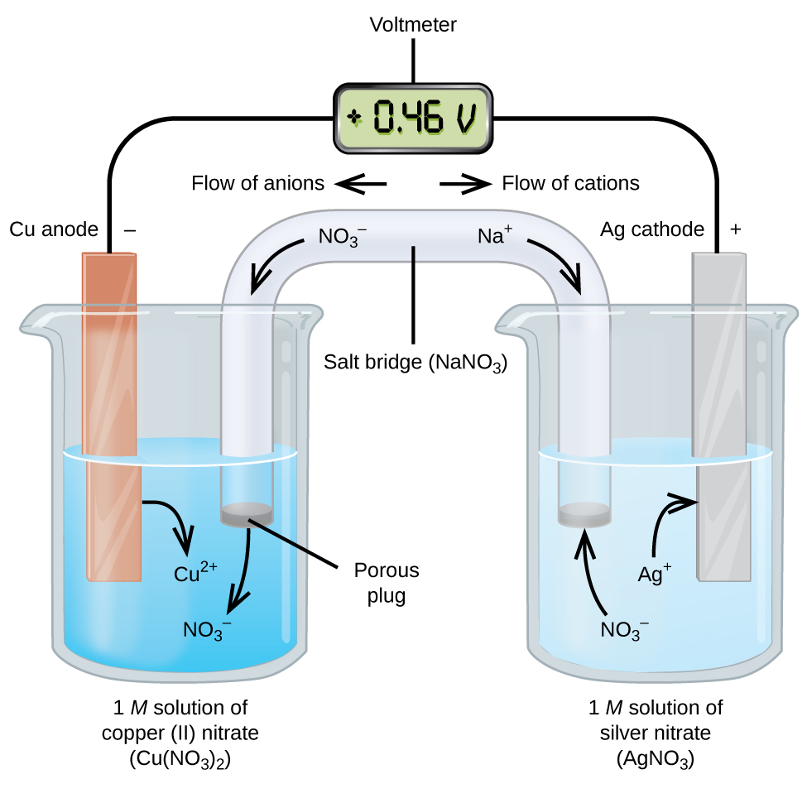- Electrochemical cell: device that transforms energy between chemical potential energy and electrical energy
Galvanic Cell: a type of electrochemical cell that transforms chemical potential energy into electrical energy in a spontaneous redox reaction that produces a voltage (potential difference), that drives an electrical current
- A galvanic cell uses two half-reactions in separate containers and makes use of the spontaneous nature of the reaction to generate an electric current
- The transfer of electrons in the redox reaction is harnessed through physical separation of the two half-reactions
- Chemical potential energy (stored in bonds) is converted into electrical energy
- If no high resistance voltmeter, concentration will change
Daniel Cell (Zinc/Copper Galvanic Cell)
- A salt bridge joins the two half cells
- It is soaked in a soluble salt solution like potassium or sodium nitrate
- Movement of ions in the salt bridge allow flow of charge through the cell and complete the circuit
- need a rod(???) with delocalised electrons, so it is non-reactive/inert
- i.e. graphite or platinum, inert electrodes
- for gas thingys
Anode and Cathode
- Oxidation reaction is anode
- Reduction is cathode
- Thus charge flows from the cathode to the anode, i.e. from reduction to oxidation
- Cations move too cathode
- Anions move to anode
Setup of Galvanic Cells
Setup and Components
- Galvanic cells are set up to allow a redox reaction to occur without direct contact between the oxidising and reducing agents
- This is achieved by physically separating the oxidant and the reductant into “half cells”
- Due to this separation, electrons are forced to flow through an external circuit, and this flow of electrons (electric current) can be utilised to do work
 What you need to include in your diagram
What you need to include in your diagram
- Anode and material
- Cathode and material
- Voltmeter and external circuit
- Salt bridge + label what it is (also at 1 mol/L)
- Electrolyte(s) + label + concentration
- Flow of ions across salt bridge
- The ‘assigned’ charge on each electrode + flow of electrons Optional but worth the effort
- The half reactions occurring under each half cell
- The condensed galvanic cell notation
Components and Purpose
Oxidation Half Cell
- Part of the galvanic cell where oxidation (loss of electrons) occurs
- Comprises of anode (primary reductant) and the associated conjugate oxidant (usually present in the surrounding electrolyte)
Reduction Half Cell
- Part of the galvanic cell where reduction (gain in electrons) occurs
- Comprises of cathode (primary oxidant) and the associated conjugate reductant (usually present in the surrounding electrolyte)
Anode
- Site of oxidation
- The anode is either the reductant itself or in contact with it
- Electrons flow out of the anode; this is assigned as being the negative terminal
- Note: as electrons leave it, if the charge is not balanced, the anode acquires a positive charge
Cathode
- Site of reduction
- The cathode is either the oxidant itself or in contact with it
- Electrons flow into the cathode; this is assigned as being the positive terminal
- Note: as electrons arrive at the cathode, if the charge is not balanced, the cathode acquires a negative charge
Electrolyte
- Solution of free/mobile ions that can conduct electricity due to their motion
- Electrodes (anode and cathode) are immersed in the electrolyte
- Always a 1 mol/L concentration aqueous solution, to meet the SRP standards
- Made of ions that may or may not include the ions of the metal or halide making the electrodes
- Purpose: it stores some reagents as well as allows the flow of charge within the cell (via ion movement)
- This flow of charge allows the circuit in the galvanic cell to be completed, and prevents accumulation of charge (electron deficit/excess) at the anode/cathode, respectively
External circuit
- A conductor joining the 2 electrodes
- Provides a pathway